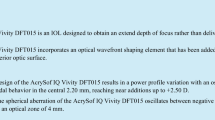Abstract
In order to better improve vision, an accurate measurement of the aberrations in the human eye has important experimental and clinical significance. An adaptive fundus camera that uses a double-column lens to correct human astigmatism is designed. In the illumination system, ring light generated by a pair of axicon lenses is used to illuminate the human eye, abandoning the traditional illumination method. In the target adjustment system, a simple real image is set, the plane mirror group and the double cylinder lens are adjusted, and the defocus and astigmatism of the human eye are corrected, so that the residual aberration of the human eye is controlled within the correction range of the adaptive imaging system. In the adaptive imaging system, a Shack–Hartmann wavefront sensor is used as a wavefront detector, and a liquid crystal spatial light modulator is used as a wavefront corrector to correct the high-order aberrations of the human eye. The lighting system and imaging system operate in different bands. The simulation results show that the illumination light path avoids the strongly reflected light of the cornea and can uniformly illuminate the human eye. The design of the adaptive imaging system achieves the diffraction limit, and the astigmatism is corrected by a cylindrical lens in the imaging system. Additional aberrations are generated, and the plane mirror is adjusted to adjust the optical path to accommodate human eyes with different diopters.















Similar content being viewed by others
References
Chen, L., Kruger, P.B., Hofer, H., Singer, B., Williams, D.R.: Accommodation with higher-order monochromatic aberrations corrected with adaptive optics. JOSA A 23(1), 1–8 (2006)
Chen, D.C., Jones, S.M., Silva, D.A., Olivier, S.S.: High-resolution adaptive optics scanning laser ophthalmoscope with dual deformable mirrors. JOSA A 24(5), 1305–1312 (2007)
Fink, W., Micol, D.: simEye: computer-based simulation of visual perception under various eye defects using zernike polynomials. J. Biomed. Opt. 11(5), 054011 (2006)
Fülep, C., Kovács, I., Kránitz, K., Erdei, G.: Simulation of visual acuity by personalizable neuro-physiological model of the human eye. Sci. Rep. 9(1), 1–15 (2019)
Han, Y., Bryanston-Cross, P.J., Shaw, K., Hero, M.: Reflectivity of the human cornea and its influence on the selection of a suitable light source for a low-cost tonometer. In: Optics in Health Care and Biomedical Optics: Diagnostics and Treatment, vol. 4916, pp. 373–377. International Society for Optics and Photonics (2002)
Huanqing, G., Zhaoqi, W., Qiuling, Z., Wei, Q., Yan, W.: Eye model based on wavefront aberration measured subjectively. ACTA Photonica Sin. 34(11), 1666 (2005)
Kaizu, Y., Nakao, S., Arima, M., Hayami, T., Wada, I., Yamaguchi, M., Sekiryu, H., Ishikawa, K., Ikeda, Y., Sonoda, K.H.: Flow density in optical coherence tomography angiography is useful for retinopathy diagnosis in diabetic patients. Sci. Rep. 9(1), 1–7 (2019)
Krueger, M.L., Oliveira, M.M., Kronbauer, A.L.: Personalized visual simulation and objective validation of low-order aberrations of the human eye. In: 2016 29th SIBGRAPI Conference on Graphics, Patterns and Images (SIBGRAPI), pp. 64–71. IEEE (2016)
Ma, C., Cheng, D., Xu, C., Wang, Y.: Design, simulation and experimental analysis of an anti-stray-light illumination system of fundus camera. In: Optical Design and Testing VI, vol. 9272, p. 92720H. International Society for Optics and Photonics (2014)
Manny, R.E., Deng, L., Gwiazda, J., Hyman, L., Weissberg, E., Scheiman, M., Fern, K.D.: Internal astigmatism in myopes and non-myopes: compensation or constant? Optom. Vis. Sci. Off. Publ. Am. Acad. Optom. 93(9), 1079–1092 (2016)
Niparugs, M., Tananuvat, N., Chaidaroon, W., Tangmonkongvoragul, C., Ausayakhun, S.: Outcomes of lasik for myopia or myopic astigmatism correction with the fs200 femtosecond laser and ex500 excimer laser platform. Open Ophthalmol. J. 12, 63–71 (2018)
Ogagarue, E.R., Lutsey, P.L., Klein, R., Klein, B.E., Folsom, A.R.: Association of ideal cardiovascular health metrics and retinal microvascular findings: the atherosclerosis risk in communities study. J. Am. Heart Assoc. 2(6), e000430 (2013)
Planchon, T.A., Mercere, P., Cheriaux, G., Chambaret, J.P.: Off-axis aberration compensation of focusing with spherical mirrors using deformable mirrors. Opt. Commun. 216(1–3), 25–31 (2003)
Qin, Z., He, S., Yang, C., Yung, J.S.Y., Chen, C., Leung, C.K.S., Liu, K., Qu, J.Y.: Adaptive optics two-photon microscopy enables near-diffraction-limited and functional retinal imaging in vivo. Light Sci. Appl. 9(1), 1–11 (2020)
Rioux, M., Tremblay, R., Belanger, P.A.: Linear, annular, and radial focusing with axicons and applications to laser machining. Appl. Opt. 17(10), 1532–1536 (1978)
Sauders, H.: A method for determining the mean value of refractive errors. Br. J. Physiol. Opt. 34, 1–11 (1980)
Smith, W.J.: Modern Optical Engineering. Tata McGraw-Hill Education, New York (2008)
Suliman, A., Rubin, A.: A review of higher order aberrations of the human eye. Afr. Vis. Eye Health 78(1), 8 (2019)
Sun, Z., Feng, Y., Chen, Y., Shi, X.Y., Tan, Z.Y.: Research of adaptive optics system for correction human eye fundus imaging. In: 2012 International Conference on Wavelet Active Media Technology and Information Processing (ICWAMTIP), pp. 173–176. IEEE (2012)
Yau, J.W., Rogers, S.L., Kawasaki, R., Lamoureux, E.L., Kowalski, J.W., Bek, T., Chen, S.J., Dekker, J.M., Fletcher, A., Grauslund, J., et al.: Global prevalence and major risk factors of diabetic retinopathy. Diabetes Care 35(3), 556–564 (2012)
Ye, H., Gao, Z., Qin, Z., Wang, Q.: Near-infrared fundus camera based on polarization switch in stray light elimination. Chin. Opt. Lett. 11(3), 56–59 (2013)
Zhang, Y., Phan, E., Wildsoet, C.F.: Retinal defocus and form-deprivation exposure duration affects RPE BMP gene expression. Sci. Rep. 9(1), 1–8 (2019)
Funding
Funding was provided by National Natural Science Foundation (NNSF) (61801455); Key Science and Technology Project of Jilin Science and Technology Department (20170204029GX). China Postdoctoral Science Foundation (2020M672053).
Author information
Authors and Affiliations
Corresponding author
Additional information
Publisher's Note
Springer Nature remains neutral with regard to jurisdictional claims in published maps and institutional affiliations.
Rights and permissions
About this article
Cite this article
Wang, D., Ouyang, R., Bi, G. et al. Design of a human eye retinal camera optical system with dual-wavelength coaxial astigmatism correction. Opt Quant Electron 52, 393 (2020). https://doi.org/10.1007/s11082-020-02472-9
Received:
Accepted:
Published:
DOI: https://doi.org/10.1007/s11082-020-02472-9




